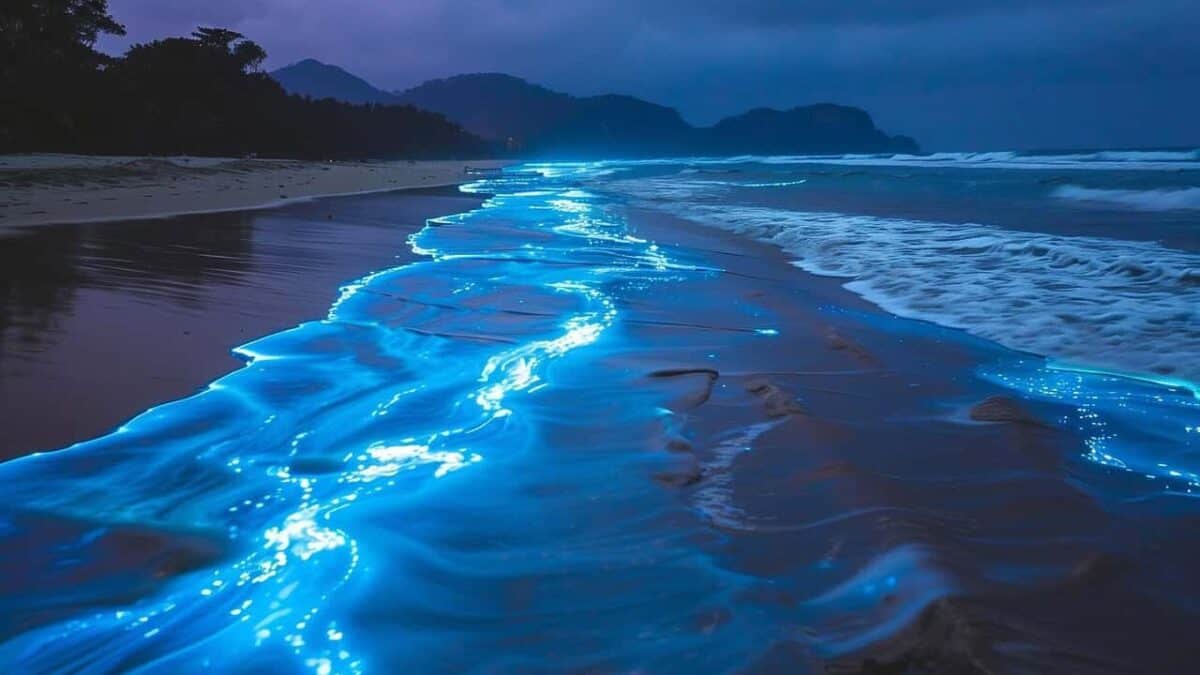In the darkest hours of night, certain waters across the United States transform into living light shows that seem almost otherworldly. This phenomenon, known as bioluminescence, occurs when microorganisms in water emit light through chemical reactions, creating a mesmerizing blue glow that ripples with every movement. From kayaking through glowing bays to watching waves crash on shore with sparks of blue light, experiencing bioluminescence firsthand is an unforgettable encounter with one of nature’s most magical displays. While bioluminescent waters can be found worldwide, the United States hosts several reliable and spectacular viewing locations accessible to nature enthusiasts and curious travelers alike. This guide explores the best places across America to witness this enchanting natural phenomenon, with tips on when to go and how to experience it to its fullest.
Understanding Marine Bioluminescence

Bioluminescence in U.S. waters typically comes from single-celled marine organisms called dinoflagellates, particularly species like Pyrodinium bahamense and Lingulodinium polyedra. These microscopic plankton emit light when disturbed—a defense mechanism that evolved over millions of years. The chemical reaction occurs when a substance called luciferin interacts with oxygen, catalyzed by the enzyme luciferase, producing the characteristic blue glow we see.
While fireflies and deep-sea creatures use bioluminescence year-round, coastal bioluminescence is typically seasonal and dependent on environmental factors including temperature, salinity, and nutrient availability. The brightness and intensity of the display can vary dramatically from night to night based on these conditions, as well as the concentration of dinoflagellates present in the water. The most impressive displays often occur during warm summer months when dinoflagellate populations bloom in protected bays and lagoons with minimal light pollution.
Mosquito Bay, Puerto Rico
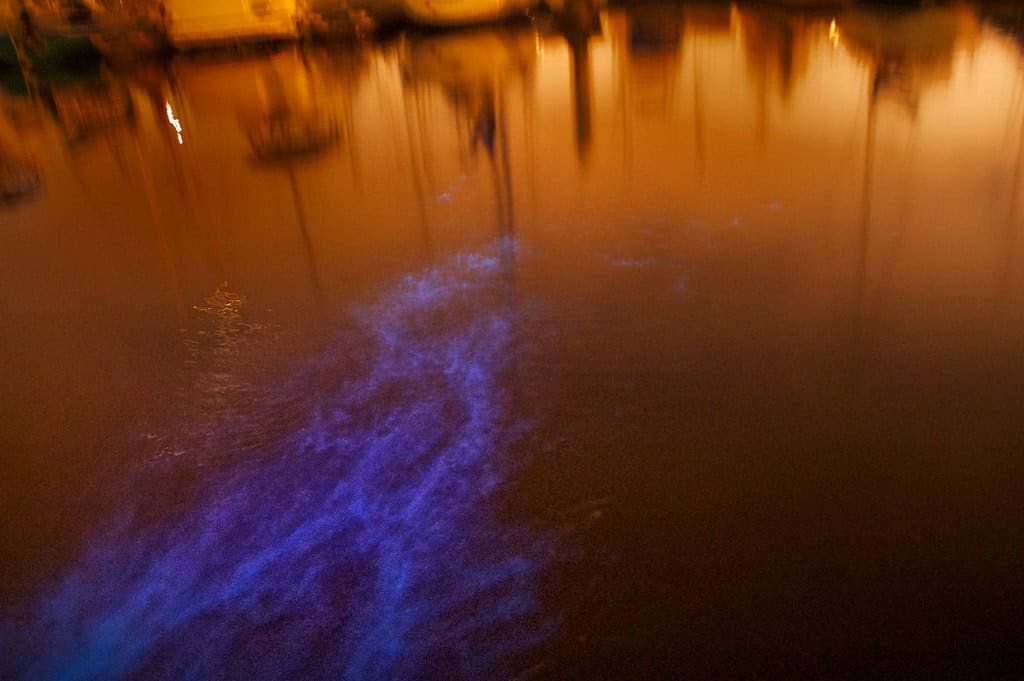
Though not in the continental United States, Puerto Rico is a U.S. territory home to what the Guinness Book of World Records has certified as the brightest bioluminescent bay in the world. Mosquito Bay (Puerto Mosquito) on Vieques Island contains consistently high concentrations of Pyrodinium bahamense, creating spectacular blue-green illumination when the water is disturbed. The bay’s narrow entrance and surrounding mangroves help trap the microorganisms while providing nutrients that sustain their population.
For the best experience, visitors should plan around the lunar calendar, as new moon nights offer the darkest skies and most vivid displays. The bioluminescence here is so bright that on good nights, you can see fish swimming underwater, leaving trails of glowing blue light behind them. Most tours operate using clear-bottom kayaks or electric boats, as gas-powered engines have been prohibited to protect the fragile ecosystem. The bay has recovered remarkably well after Hurricane Maria in 2017, which temporarily diminished its bioluminescent intensity.
Indian River Lagoon, Florida

Florida’s east coast hosts one of the most accessible bioluminescent experiences in the continental United States. The Indian River Lagoon system, particularly around Merritt Island and the Banana River, comes alive with bioluminescence during summer months from June through October. Unlike many locations where dinoflagellates create the light show, this area’s glow comes primarily from comb jellies and dinoflagellates, offering visitors a unique two-species bioluminescent experience.
The warm, brackish waters of this estuary system create ideal conditions for bioluminescent organisms to thrive. Several tour companies operate in the area, offering guided kayak trips through narrow mangrove tunnels where paddlers can watch mullet fish jump and create explosive bursts of blue light upon re-entry. The protected waters of Merritt Island National Wildlife Refuge provide a dark-sky environment relatively close to Orlando, making it a popular destination for tourists seeking natural wonders beyond the theme parks.
Tomales Bay, California
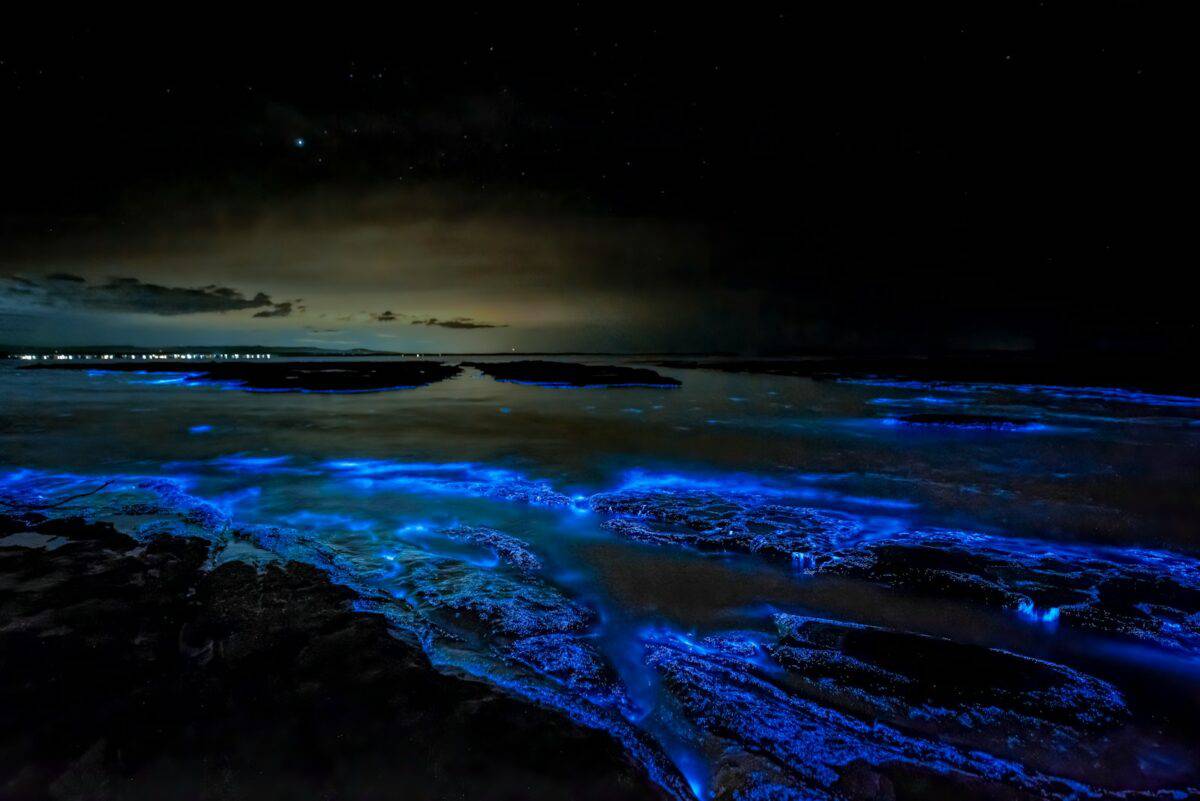
Northern California’s Tomales Bay offers one of the West Coast’s most reliable bioluminescent experiences. Located within Point Reyes National Seashore about an hour north of San Francisco, this narrow 15-mile inlet becomes illuminated by Lingulodinium polyedra dinoflagellates primarily during late summer and fall months. The sheltered bay’s unique geography creates ideal conditions for these organisms to concentrate, particularly during algal blooms known as red tides (which, despite the name, produce blue bioluminescence at night).
Visitors can rent kayaks or join guided evening tours that typically launch around 8 PM and paddle through the darkness. The experience is particularly magical because of the bay’s relatively undeveloped shoreline and distance from major cities, resulting in minimal light pollution. Unlike some bioluminescent destinations, Tomales Bay allows for swimming in the glowing waters during warmer months, creating unforgettable moments as swimmers become outlined in blue light with every movement. The area is also known for its oyster farms and wildlife, adding daytime attractions to complement the nighttime light show.
Manasquan Beach, New Jersey
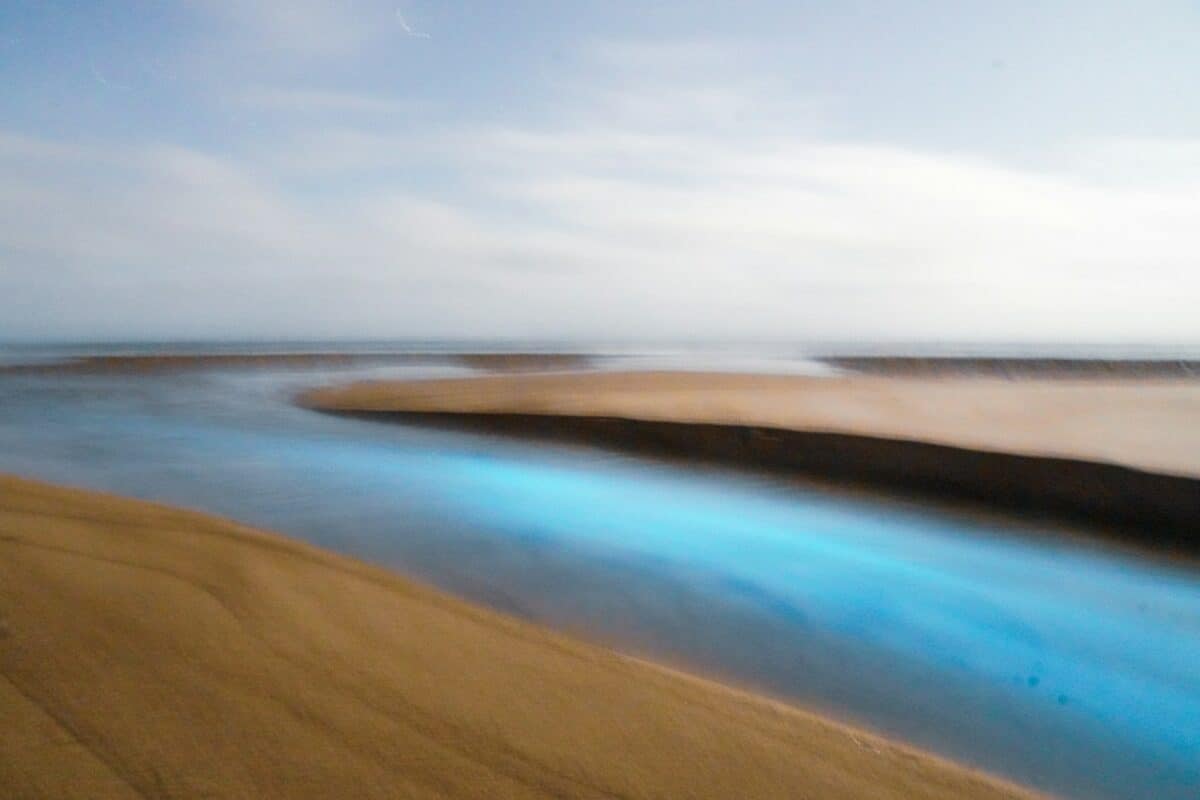
The Jersey Shore might be better known for its boardwalks and beach culture, but during late summer, Manasquan Beach and other nearby coastal areas occasionally host spectacular bioluminescent displays. These events are less predictable than those in more famous bioluminescent destinations, occurring when specific conditions align to create algal blooms. When they do happen, typically between July and September, waves breaking on shore illuminate with blue flashes, and footprints in wet sand temporarily glow with each step.
What makes the New Jersey bioluminescence special is its accessibility to major population centers like New York City and Philadelphia. Unlike remote bays requiring boat access, these displays can sometimes be witnessed by simply walking along the beach at night. The phenomenon depends heavily on water temperature, nutrient levels, and other environmental factors, making it somewhat unpredictable. Local photography groups and nature enthusiasts often share real-time updates on social media when bioluminescence appears, helping others catch these fleeting displays.
San Diego’s Beaches, California
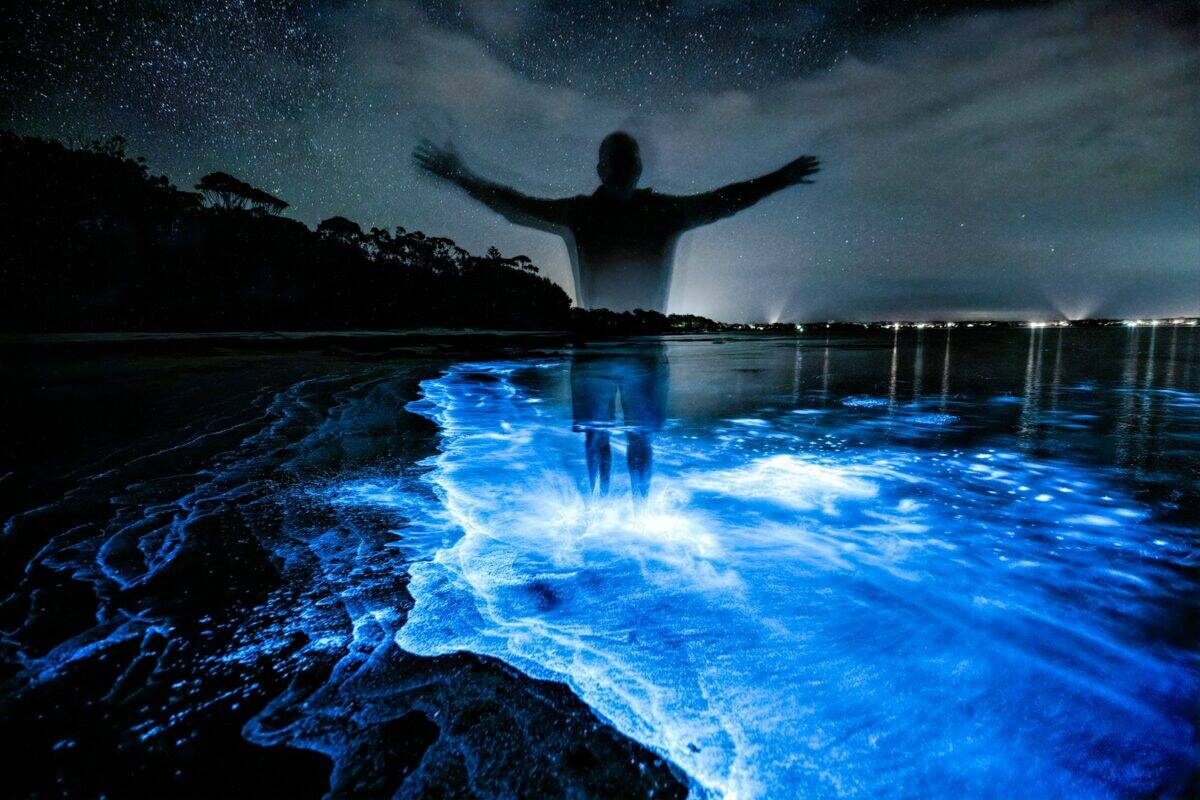
Southern California, particularly the San Diego coastline, periodically experiences dramatic bioluminescent red tides that transform into neon blue waves at night. These events, caused by massive blooms of Lingulodinium polyedra, are irregular but typically occur in spring and summer months. When conditions align, beaches from La Jolla to Encinitas become natural light shows, drawing crowds of nighttime beach-goers and photographers. The bioluminescence here is visible directly from shore, with each breaking wave creating a cascade of blue light.
The most memorable San Diego bioluminescent event in recent years occurred in 2020, when an extensive red tide created weeks of spectacular nighttime displays. During these events, surfers report glowing blue outlines around their boards and bodies while riding waves in darkness. While the daytime appearance of red tides (rusty-colored water) can be unappealing and sometimes accompanied by unpleasant odors as algae decay, the nighttime transformation makes these natural events worth experiencing. Torrey Pines State Beach, Moonlight Beach, and Scripps Pier are popular viewing locations when bioluminescence occurs.
Elk River, Charleston, Oregon
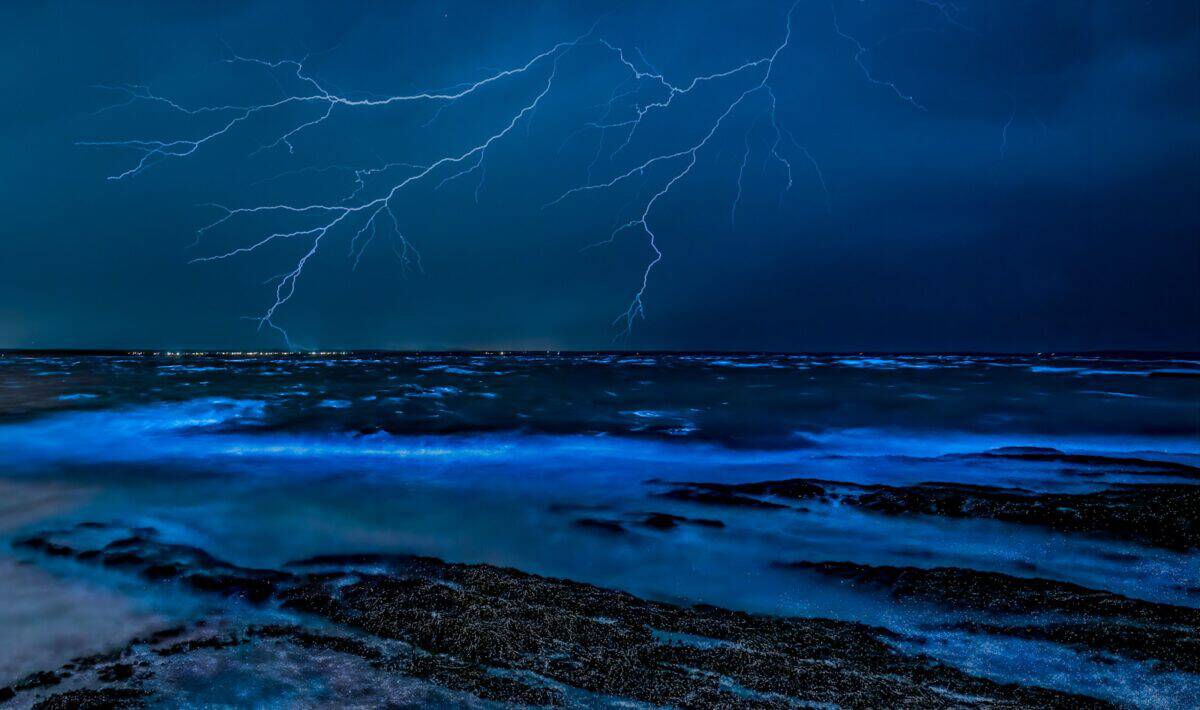
The Pacific Northwest offers its own unique bioluminescent experience along the Elk River near Charleston, Oregon. This location is less known than others on this list but provides a distinctive opportunity to witness bioluminescence in cooler waters. During summer months, particularly July through September, kayakers and paddleboarders can experience glowing waters in the river’s estuary system. What makes this location special is the combination of bioluminescent microorganisms with the region’s lush, temperate rainforest environment.
Local tour operators offer guided nighttime kayak trips that often include sightings of other marine life like harbor seals and river otters, whose movements trigger additional bioluminescent reactions in the water. The phenomenon here tends to be more subtle than in tropical locations, requiring fully dark-adapted eyes to appreciate fully. The best viewing conditions occur during new moon periods when ambient light is minimal. The cooler water temperatures mean fewer swimmers experience bioluminescence directly, but kayakers often report seeing fish darting beneath their boats, temporarily illuminated by the microorganisms they disturb.
Mission Bay, San Diego, California

Beyond its ocean beaches, San Diego offers another bioluminescent destination in Mission Bay, a saltwater lagoon in the heart of the city. During certain times of year, particularly late summer to early fall, this bay experiences bioluminescent dinoflagellate blooms that illuminate its calm protected waters. The controlled environment of this lagoon creates unique viewing opportunities, as the still waters show off bioluminescence with minimal wave action, revealing the delicate patterns created by water movement.
What makes Mission Bay special is its accessibility and infrastructure. Visitors can rent kayaks, paddleboards, or pontoon boats even in evening hours from various rental facilities around the bay. The surrounding park offers nighttime access points and enough darkness to view the phenomenon despite being within city limits. The predictable conditions and relatively shallow, protected waters make this an ideal location for families with children to experience bioluminescence safely. Local nature centers occasionally offer guided programs about the phenomenon when conditions are favorable.
Chassahowitzka River, Florida

Florida’s Gulf Coast offers bioluminescent experiences distinct from the Atlantic side. The Chassahowitzka River, flowing through Citrus County into the Gulf of Mexico, hosts bioluminescent comb jellies that create a different kind of light display than dinoflagellates. These transparent, walnut-sized organisms produce a more persistent glow that doesn’t require agitation to activate. During winter months (November through February), contrary to most summer bioluminescent experiences, these jellies populate the river in numbers large enough to create noticeable bioluminescence.
Kayakers and boaters report seeing the water appear to contain countless underwater stars as they move through areas populated by these creatures. The Chassahowitzka is already famous for its crystal-clear springs and manatee populations, making bioluminescence an added attraction to an already spectacular natural area. The best viewing occurs about 1-2 miles downstream from the main spring, where freshwater mixes with saltwater from the Gulf, creating the brackish conditions these organisms prefer. Local outfitters offer specialized night tours during peak season that combine wildlife spotting with bioluminescent viewing.
Savannah River and Tybee Island, Georgia

Georgia’s coastal waters around Tybee Island and the Savannah River delta experience periodic bioluminescent displays during summer months. The complex estuary system, with its mixture of freshwater and saltwater, creates diverse habitats where different bioluminescent organisms thrive. The nutrient-rich waters support healthy populations of dinoflagellates that illuminate from June through September, with peak activity usually occurring in August when water temperatures are highest.
Local kayak companies offer nighttime tours through the salt marshes and tidal creeks, where the narrow waterways amplify the visual impact of the bioluminescence. What makes this area unique is the combination of bioluminescence with the distinctive Southeastern salt marsh ecosystem, complete with oyster beds, herons, and occasional alligator sightings. The historic Savannah River, which has played such an important role in American history, takes on a magical quality when its waters glow blue at night. The phenomenon is generally more visible during neap tides, when water movement is minimized, allowing dinoflagellates to concentrate in certain areas.
San Juan Island, Washington

The San Juan Islands of Washington State offer some of the northernmost bioluminescent experiences in the continental United States. These waters host a different species composition of bioluminescent organisms adapted to cooler temperatures. The best viewing locations include Lime Kiln Point State Park and the sheltered bays around Friday Harbor on San Juan Island. The phenomenon typically occurs from late July through September, with displays visible from shore or by kayak.
What makes bioluminescence in the San Juan Islands special is the backdrop of the archipelago’s stunning scenery and rich marine ecosystem. These waters are famous for resident orca populations, and though whales are rarely seen at night, the same currents that support the larger marine food web also concentrate bioluminescent organisms in certain areas. The islands’ distance from major urban centers provides exceptional dark skies, making even subtle bioluminescence visible. Several local outfitters specialize in “bioluminescent paddles” that launch about an hour after sunset, taking advantage of the protected waters between islands that remain calm enough for clear viewing.
Tips for Viewing Bioluminescence
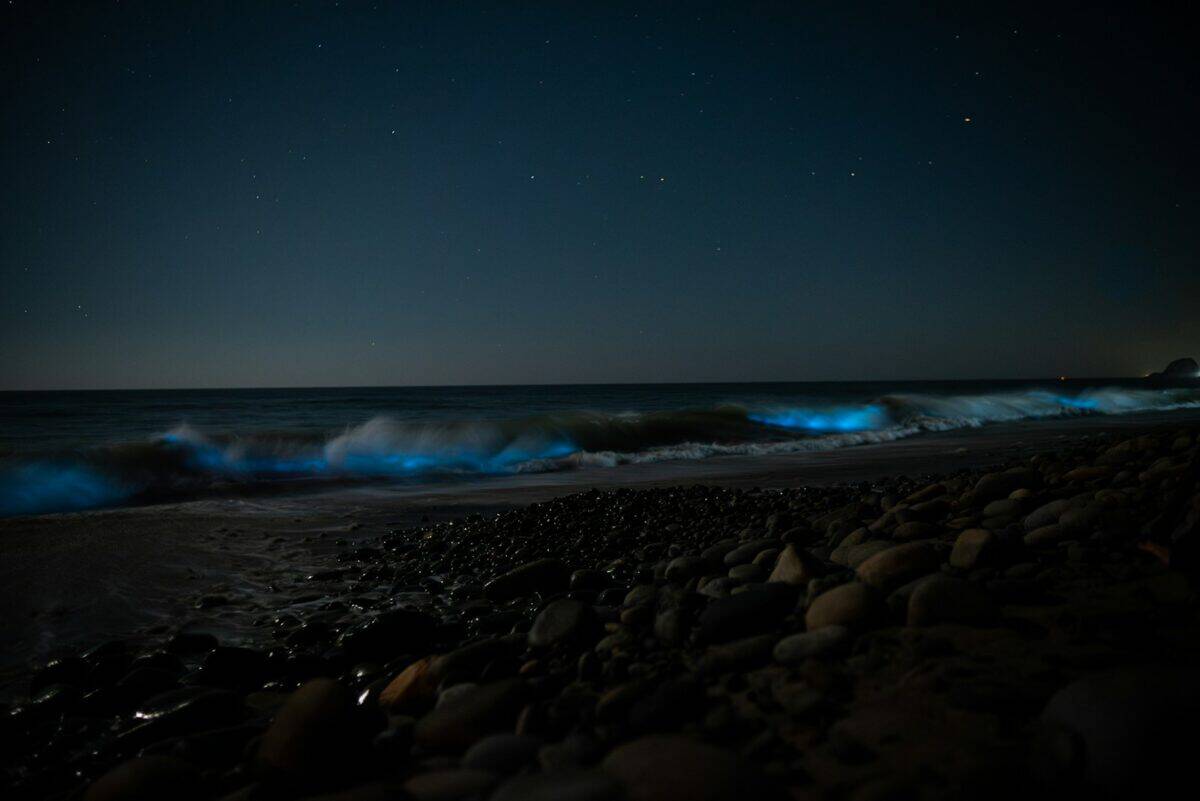
Successful bioluminescence viewing requires some planning and knowledge. Timing is crucial—most locations show the strongest displays during summer months, but specific bloom periods vary by region. Consulting local tour operators or marine research institutions can provide up-to-date information on current conditions. The lunar cycle significantly impacts visibility, with the days around the new moon offering the darkest skies and best viewing conditions. Arriving at your chosen location at least 30 minutes before you plan to enter the water allows your eyes to fully adapt to darkness.
Equipment considerations matter too. If kayaking, choose clear-bottomed kayaks where available for the most immersive experience. Bring red-light headlamps rather than white lights, as red light preserves your night vision while providing necessary illumination for safety. Waterproof cameras with high ISO capabilities can capture the experience, though professional photography usually requires specialized equipment. Most importantly, respect the fragile ecosystems where bioluminescence occurs—avoid chemical repellents before entering the water, follow all local regulations, and practice no-trace principles to preserve these magical environments for future visitors.
Experiencing Nature’s Light Show

Bioluminescent waters represent one of nature’s most magical displays, creating memories that last a lifetime for those fortunate enough to witness them. From Puerto Rico’s record-breaking brightness to the seasonal displays along continental U.S. coastlines, these living light shows connect us to the microscopic wonders that inhabit our waters. The transient nature of bioluminescence—dependent on environmental conditions, seasons, and even nightly changes—makes each encounter unique and precious. The experience reminds us of the complexity and wonder of marine ecosystems that often go unnoticed in daylight hours.
As climate change and coastal development increasingly impact marine environments, witnessing and appreciating phenomena like bioluminescence becomes not just a tourist activity but an opportunity for environmental education and appreciation. Many tour operators now combine bioluminescent excursions with information about marine conservation, helping visitors understand the delicate balance that supports these displays. Whether you’re watching glowing waves crash on San Diego’s shores, paddling through Florida’s illuminated lagoons, or floating in Puerto Rico’s radiant bays, experiencing bioluminescence firsthand creates a profound connection to the living oceans that cover our planet.
- This Fish Has the Most Teeth in the Ocean—And Uses Them Well - August 9, 2025
- How Wolves Use Group Howls to Reunite With Pups - August 9, 2025
- 12 Dog Breeds That Form the Deepest Emotional Bonds with Their Owners - August 9, 2025

